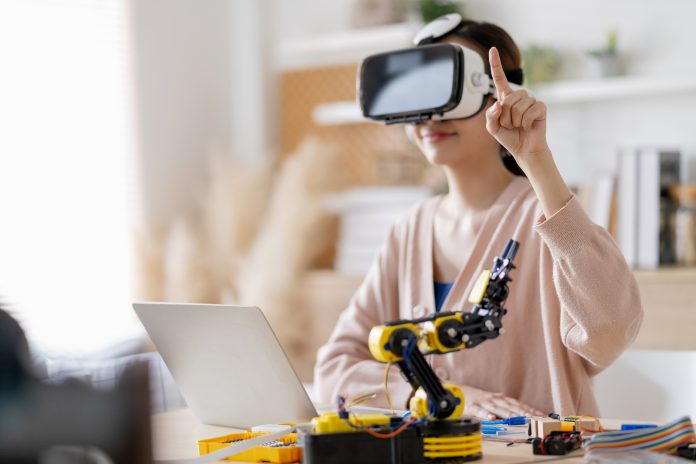The assimilation of artificial intelligence in education is transforming education as we know it in unimaginable ways. It promises to radically reshape how we learn, teaching us new things unthinkable before and potentially making education more efficient and effective for students – making an impressionful statement about its potential use within educational systems and sparking great excitement among educators everywhere.
AI-powered teaching can serve as a helpful aide for teachers by simplifying administrative tasks such as communicating with parents, analyzing reports, and sending emails – tasks that often become cumbersome burdens on educators. AI can assist teachers by freeing them up for classroom and student time more easily than before – as well as provide instant answers to students with any inquiries about their work or concerns they might have, saving their time and effort.
Artificial intelligence in education has generated much debate within institutions that have begun adopting it into their learning models and models of instruction. AI can play an invaluable role in teaching and learning environments, expanding access to disadvantaged groups and shortening learning time – making the lessons more relevant to today’s society. Furthermore, this technology has become essential to modern education – educators should embrace its benefits!
Though AI is all set to revolutionize the education industry, it also comes with challenges that are essential to address if schools and colleges plan to adapt it. Educators and teachers often lack the skills or resources necessary to deal with AI. They may also be overworked and untrained. To deal with this issue, Some of the best schools in Vadodara have started a number of teacher training programs to help educators deal with this and easily transition to the new technology.
The Impact of AI-Powered EdTech Innovations:
Personalized Learning
The personalized learning movement strives to customize each student’s curriculum and learning process in accordance with their individual skills, abilities, interests, and background. This approach seeks to enhance a range of educational outcomes, from student Engagement through achievement to wellbeing. Teachers have long used personalized learning techniques in their lessons. This may mean offering students more control over how and when they learn or giving them greater choice in choosing their homework tasks and pace of work. It may involve setting goals and tracking progress toward them.
Educational technology can amplify these methods by personalizing how students engage with content, communicate with instructors, and interact with one another. Students using an AI system displaying facial expressions via virtual avatar were likelier to feel at ease during lectures. However, further research is needed to understand how AI-powered teaching methods can be best integrated into educational curriculums.
Enhanced Administrative Tasks
Manually managing administrative tasks can be time-consuming, error-prone, and ultimately limit productivity. Furthermore, this approach limits attention given to student responsibilities and their overall growth. The good news is various automation tools and EdTech innovations are available to educational institutions that can streamline their processes, such as student information systems, digital forms and workflows, learning management systems, and communication platforms – each offering specific benefits to education.
Student information systems (SISs) can centralize and automate enrollment processes for educators. Automating these processes enables educators to focus on student-centric responsibilities while expanding their business. Likewise, identity verification software streamlines students’ onboarding, saving money and allowing educational institutions to work more efficiently.
Intelligent Tutoring Systems
A great way of using machine learning in schools is Intelligent tutoring systems (ITSs). These educational software programs use machine learning to improve student outcomes. ITSs can assist students with understanding concepts through problem-solving and offering feedback or guidance when necessary. They may even automate certain administrative tasks for teachers so that more time can be dedicated to classroom instruction and support. ITS programs differ significantly in design, implementation, and educational focus, making evaluation difficult.
Some of the best schools in Vadodara are already adapting ITS technology to their teaching methodologies, making it easier and more efficient than ever for teachers to harness the endless power of technology. This way, teachers can deliver more student-centric learning solutions to the students, helping them get along with the course in a better way.
Automated Grading and Feedback
Grading assignments and providing feedback is time-consuming for teachers, and automated grading and feedback systems simplify the task so educators can spend more time focused on other aspects of teaching. AI-powered t involves highly upgraded software that offers consistent evaluations that eliminate biases and personal opinions, reducing errors and unfair assessments.
Teachers can utilize automated grading systems to design assessment criteria that align with educational objectives while offering guidance to facilitate students in online learning environments.
Grading and feedback are important in understanding students’ individual needs and making the best-suited learning environment for them. With the help of automation in education, schools, and educational institutions can now efficiently generate and assess insightful data that helps them create a highly interactive learning environment for students.
Smart Content Creation
Modern digital-first businesses produce and accumulate content rapidly. Unfortunately, information overload and frustration often result from a lack of proper strategies to guide and adapt it to users or contextualize it in real time. Therefore, intelligent content should be an indispensable asset of any organization. EdTech Innovations have made it possible for schools and colleges to offer smart content, leveraging multiple factors to produce the most relevant and timely information at precisely the moment it’s required for their students.
For optimal smart content creation, it is vital to first gain an in-depth knowledge of your students and their behavior. Understanding this aspect of their habits, lifestyles, and preferences will allow educators to distinguish which requirements are necessary versus those that would make an excellent “nice to have.” Furthermore, smart content should always aim to offer a more engaging experience.
Importance of AI in Education
Artificial intelligence has quickly become an invaluable asset to education providers. AI can assist with administrative tasks, personalize student learning experiences, and help teachers better comprehend student needs. Furthermore, artificial intelligence in education provides access to tutoring for those who otherwise would not receive it. It also provides teachers with new ways of engaging their pupils by offering resources they wouldn’t normally have access to.
AI-powered teaching can help address some major educational issues. Still, it will be even more successful when combined with technologies like virtual and augmented reality to bring lessons alive for students. Moreover, post-COVID-19, It has become challenging for students to attend traditional classroom settings. It has driven them toward adopting innovative technologies and remote learning and working practices – this trend is particularly true within higher education.
Teachers often spend too much time performing administrative tasks like grading assignments and answering student queries when this could be spent more effectively on more essential activities like building relationships with their pupils. AI technology can automate many of these administrative duties to free up teachers for more important activities like relationship-building with their pupils. Furthermore, adaptive Learning Systems enable teachers to tailor their teaching strategies appropriately.
AI-powered teaching can make learning more engaging for students by giving them access to various tools designed to support individual ways of studying, such as interactive digital textbooks, study guides, and bite-sized lessons. AI can also create different ways of perceiving information, such as visualization or virtual reality environments – AI can keep teachers abreast of developments in their fields while making incorporation easier for curriculum developers.
Conclusion
Adaptive learning systems in education have seen steady expansion and will remain an indispensable force. AI-powered educational models can boost any teaching institution’s value proposition and objectives; also essential is carefully considering how they will affect students’ career paths. Innovative institutions will embrace this trend by including AI in their curriculum to prepare students for tomorrow’s world of work.
AI is revolutionizing the education industry, and some of the best schools in Vadodara have already started embracing it as part of their strategy to become inclusive and fair places for learning. AI can enhance overall quality, increase student engagement, raise interest levels in studies, reduce stress levels, and make the learning process more fun; taking advantage of all these benefits could transform the education sector into an inclusive and fair space for everyone involved.





